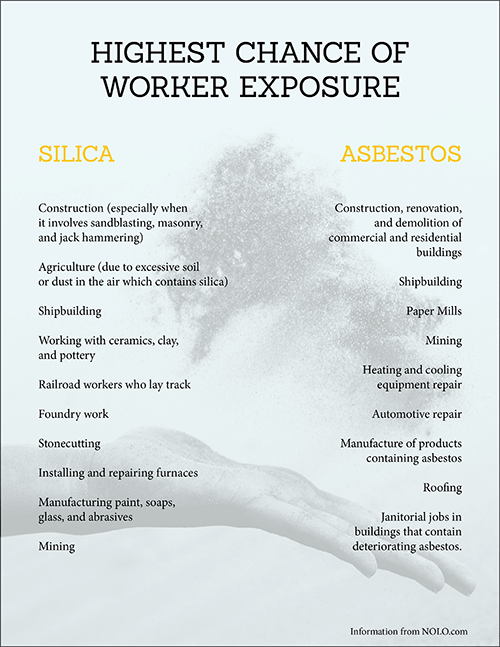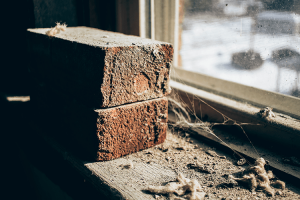Silica is a common mineral found in many materials, including soil, sand, concrete, masonry, rock, and granite. When these materials are cut, ground, drilled, or otherwise disturbed, they release tiny, invisible particles of crystalline silica dust into the air.
This dust is highly hazardous to human health, particularly when inhaled.
Silica exposure can cause a wide range of diseases, many of which are progressive. The tiny particles of silica dust cause scarring and inflammation in the lungs, leading to the formation of lung nodules and increasing the risk of lung cancer.
Chronic exposure can also result in pulmonary fibrosis, chronic obstructive pulmonary disease (COPD), and other serious respiratory conditions. Additionally, silica exposure can increase the risk of bacterial infections, such as tuberculosis.
In this article, we aim to examine just a few of the hazards related to working with silica, and how you can protect your team.
Related Article: Breaking Down the Silica Physical Exam
Related Article: New OSHA Initiatives to Combat Silica Exposure in Engineered Stone Industry
The Asbestos & Silica Connection
Asbestos has been a deadly word in various industries since 1929, when the first lawsuit was filed.
This natural silicate material is responsible for about 15,000 deaths each year, as each day, nearly 1.3 million Americans face exposure at their workplace.
Now, respirable crystalline silica, which is the second most abundant mineral on Earth, is quickly gaining a similar reputation, with approx. 2.3 million workers exposed to it annually.
Silica, like asbestos, is dangerous when inhaled.
Both of these exposures occur when workers cut, grind, crush, or drill materials containing the dangerous substances creating very small dust particles. Invisible to the naked eye, workers are often unknowingly exposed, until severe health issues occur months, or even years later.
With OSHA’s new silica rule in effect for engineered stone industry, construction, maritime, general industry, and soon for hydraulic fracturing, the general public is becoming more aware of the connection between silica exposure and lung diseases, much like it did in the late 1970’s with asbestos.
As silica, which is quite literally everywhere, climbs to the top of many employers’ agendas, it might be fair to consider it as the modern-era asbestos.

All Too Familiar
Words like mesothelioma and asbestosis are synonymous with asbestos.
Over the past four decades, billions of dollars have been awarded in mesothelioma cases, causing more than 100 companies to file for bankruptcy. When it comes to silica, we’re now becoming familiar with the terms silicosis and COPD.
Both diseases, like mesothelioma and asbestos, cause severe, often lethal, lung damage. Silicosis is brought upon by inhaling even trace amounts of silica particles.
Over time, these silica particles scar the lung tissue, leading to difficulty breathing. Asbestosis has an eerily similar effect, as they both cause forms of lung fibrosis.
There are three types of silicosis to be aware of:
- Acute silicosis: Occurs within a few weeks or years of exposure and causes coughing, weight loss, and fatigue.
- Chronic silicosis: Occurs when workers experience low, yet constant exposure to the hazardous material. Lung scarring can appear 10 to 30 years after exposure.
- Accelerated silicosis: Occurs within 10 years of constant, high exposure to silica.
OSHA estimates that between 1,000 and 1,500 people die each year due to silica exposure.
Already, there has been an abundance of silica-related lawsuits and deaths. In 2009, a former sandblaster was awarded $7.9 million against his employer in Mississippi after contracting silicosis.
For years, companies looked for ways to hide the dangers of asbestos because of its prevalence throughout industry. However, those decisions inevitably came back to haunt them.
In recent years, all too many employers have been looking for ways around silica testing and employee education requirements. Therefore, it’s highly conceivable that silicosis lawsuits will run parallel with those brought about by mesothelioma.
If you think silica testing is too expensive to be worthwhile, then you might want to rethink your stance and use asbestos as a reference.
Health Effects of Silica Exposure
Exposure to respirable crystalline silica increases the risk of other lung diseases, primarily COPD, which includes emphysema and chronic bronchitis. The main health effects of silica exposure are lung disease and lung cancer.
It only takes a very small amount of airborne silica dust to create a health hazard, making it a significant occupational hazard.
Prevention and Protection
To mitigate the risks associated with silica exposure, it’s essential to wear protective gear, including respirators, in any situation where you may be exposed to these dangerous dusts.
The Occupational Safety and Health Administration (OSHA) has regulations in place to keep worker exposures at or below a Permissible Exposure Level (PEL) of 50 µg/m³.
Employers must ensure that workers are protected from silica exposure through the use of engineering controls, administrative controls, and personal protective equipment.
(Related: Respirable Crystalline Silica Medical Testing)
It’s Up to You
As you may know, OSHA released a new rule on silica this April, reducing silica dust exposure in mining industries, better protecting miners’ health from irreversible workplace illnesses.
The new silica rule mandates that workers must undergo a series of medical surveillance tests.
OSHA is taking these rules seriously with fines reaching $16,131 per serious, other-than-serious, or posting requirements violation, and upwards of $ 161,323 per willful or repeated violation.
OSHA believes that these new restrictions will help save thousands of lives, and keep silica from truly becoming the next asbestos.
Ultimately, the responsibility is on employers to make sure they remain in compliance and keep their workers healthy.
- See OSHA Safety and Health Regulations for Construction: Respirable crystalline silica (1153).
- See OSHA Occupational Safety and Health Standards: Respirable crystalline silica (1053).
- See OSHA Instruction: National Emphasis Program – Respirable Crystalline Silica.
- See OSHA Standard on Respirable Crystalline Silica Focused Inspection Initiative in the Engineered Stone Fabrication and Installation Industries.
Bringing It Together
Silica is a significant occupational hazard that can cause serious respiratory diseases and lung cancer. The similarities between silica and asbestos underscore the importance of proper protection and prevention measures in workplaces where these materials are used.
By understanding the health risks and implementing effective safety protocols, we can reduce the incidence of silica-related diseases and protect workers’ health.
About Worksite Medical
To protect your team and remain in compliance with OSHA , you need to find a medical provider in your area that specializes in occupational health.
In the case of Worksite Medical, we make that easier with mobile medical testing that reaches across the US.
With Worksite Medical, you can get all the resources of a lab brought directly to your worksite, minimizing your workers’ downtime.
We’ll tailor a comprehensive medical surveillance program to your specific needs. Our services include, silica exams, physical testing, heavy metal labs, PPE fit testing, x-rays, audiometric exams, and much more. We safely maintain all of your team’s medical records, and provide you with quick access.
You’ll keep your employees at work, and stay ahead of OSHA inspections.
Protect your team and your workplace now with Worksite Medical. Not sure what you need? Try our medical testing wizard here.
Give us a call at 1-844-622-8633, or complete the form below to schedule an on-site visit or to get your free quote.
Convenient, Compliant Occupational Medicine. Worksite Medical – Let Us Come to You!




